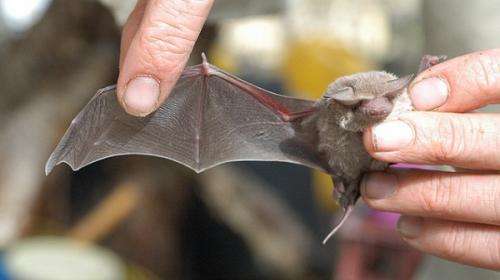Bat wing practice maximises flight efficiency

Australian bats developed a high-speed flying technology some 50 million years before aircraft engineers, according to Department of Parks and Wildlife zoologist Norm McKenzie.
"It's called, among people who design aircraft, flat plate aerodynamics," Mr McKenzie says.
"In modern aircraft, the very latest airframe designs, you get much of your lift off the body of the aircraft rather than body of the wings so it cuts the turbulence down and therefore saves energy.
"Flat plate aerodynamics has not been recognised in animals before."
Together with aerodynamics engineer Bob Bullen, he made the discovery after several years studying bats in their spare time.
"During our studies of bat flight and their foraging strategies we noticed two things," he says.
"Some small West Australian bats of a particular group can entirely flatten their wings.
Flying animals, like aircraft, have curved or cambered wings which provides lift.
The wing beat of flying birds and bats and insects provides a thrust but the profile of the wing as it cuts through the air provides lift.
Camping trip delivers second enigma
The other puzzle came when they were camping at Cape Kerauden in the Pilbara.
"I was doing some slow motion photography of bats flying out over the mangroves," he says.
"I was watching the bats belonging to the genus Mormopterus as they hunted round the mangroves just after dusk.
"A group of them suddenly gained a bit of altitude and then suddenly took off over my head and up the coast at high speed.
"They accelerated to over 40km/hr which on our calculations was highly unlikely.
"Not only did they accelerate but they were flapping their wings more slowly than they were doing when they were hunting above the canopy at lower speed."
They spent several years dissecting bats, taking measurements, and making calculations before announcing that at least three species of Mormopterus and one of Tadarida practice flat plate aerodynamics.
"It pulls its tail membrane up against its crotch, so the whole airfoil, the whole wing and body is not as long," Mr McKenzie says.
"That means the air is dragging over the surface of the bat for a shorter distance so there's less drag.
"And the most clever thing is it straightens its wing out.
"It either saves it a lot of energy when it's travelling distances or it travels those distances much quicker."
Notes:
Mr Bullen is proprietor of the conservation biology consultancy Batcall.
They analysed 22 bat species for the study, and found flat plate aerodynamics capabilities in (Mormopterus beccarii, M. loriae, M. planiceps and Tadarida australis).
Provided by Science Network WA


















